Bridge Basics
Check out MiniBridge Basics for an introduction to the game. Then see this help file for more details of the Trickster Bridge implementation.
Bidding
Trickster Bridge supports the bidding conventions of the Standard American Yellow Card (SAYC). This Preview recognizes a large subset of possible SAYC bids. When we encounter an unimplemented sequence, our computer players will pass or suggest you pass.
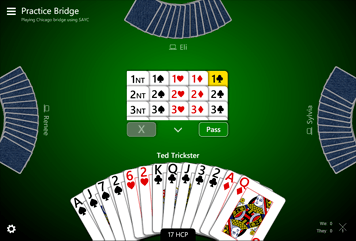
Screen shot showing first bid
We present possible bids using a digital replica of a standard bidding box. We highlight the suggested bid in yellow; suggestions to pass, double, and redouble are highlighted with a white glow around the button. During bidding, we display your count of high card points at the bottom of the screen.
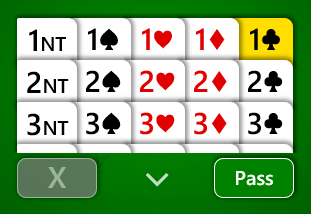
Bidding box with 1♣ suggested
When you move your mouse over any bid (or press and hold on a bid on a touch screen), we display a bubble explaining the bid.
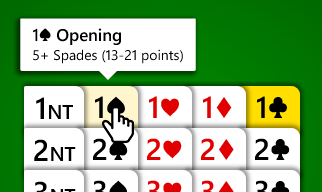
Hovering over the 1♠ bid shows what it means
To make a bid, simply click or tap it.
After all players have placed their first bids, the game board will look similar to this:
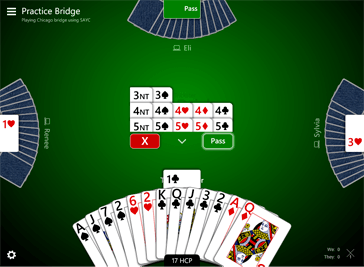
Note how players’ bids are displayed. If you click or tap a placed bid, we explain what that bid means in SAYC.

Explanation of LHO’s bid
Play of the Hand
Once the final contract is established, the declarer’s bid is displayed over his or her cards. The count of the number of tricks taken is displayed after the declarer’s name followed by a slash and the number of tricks required to fulfill the contract.
Play begins with the player to the declarer’s left leading. The dummy’s cards are exposed after the lead which is the first play of the dummy.
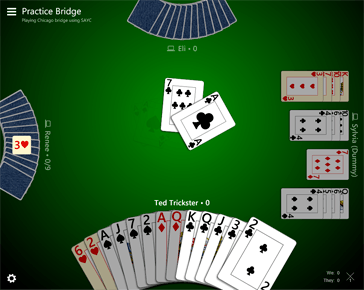
Board with dummy exposed
On large enough screens, the dummy is displayed in traditional layout; on smaller screens it displays as a flat spread of cards.
Play proceeds as you’d expect. Click or tap a card to play it. Your suggested card is displayed slightly raised. In the Preview, these suggestions are dummy-aware but still sub-optimal; no conventions are followed for the defensive lead.
Declarer Play
When you are the declarer, you play both your hand and the dummy’s hand. Dummy’s suggested cards are displayed slightly left-shifted. In both hands, you simply click or tap a card to play it.
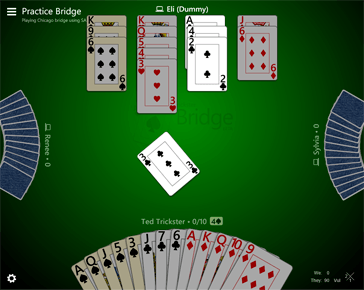
Board showing dummy’s suggested card
Scorecard
The scorecard is displayed automatically at the end of each hand. You can display it at other times by choosing the Scores item from the main menu.
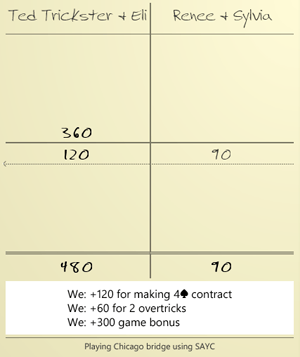
Scorecard after two hands
The scorecard shows contract and bonus points for each team along with a total at the bottom. It also displays an explanation of the points awarded in the last hand. Game winners are designated by the dotted line with the small arrow indicating the team that won that game.
The score summary in the lower right corner of the screen (displayed only when there’s room) shows the total score for each team, an indication of which team is vulnerable, if any, and, in Chicago bridge, the traditional X display indicating the current hand out of four.

Score summary during hand 3
Bridge House Rules Options
When
“Now” creates a new game that starts immediately. Other options schedule a game for a time in the next 24 hours. Compete and Join games only.
Winnings
Four levels of winnings based on the buy-in level—30, 110, 275 or 550 Trickster Chips. Compete games only.
Variation
“Chicago” is always four deals scored Chicago-style. “Rubber” is played until one team completes two games of 100 contract points each or for a set number of hands (see Number of hands, below). “Mini” is MiniBridge, which uses simplified bidding.
Partscores
“+50 Bonus” awards a 50-point bonus for partscores (duplicate style). “Carry Forward” means partscores carry forward from deal-to-deal to make game (rubber style). Chicago variation only.
Number of hands
“1”, “4”, “6”, “8”: exactly that number of hands are played. “No Limit”: hands continue until one team wins 2 games. Rubber variation only; 1 available in Practice only.
Play
“To score” plays the game until one team achieves the score set in “Play to score.” When “# of hands” is selected, the game is played only for the number of hands selected in the “Play # of hands” option. MiniBridge only.
Play to score
Sets the game over score when the “Play” option is set to “To score.” MiniBridge only.
Play # of hands
Sets the number of hands to be played when the “Play” option is set to “# of hands.” When the number of hands is completed, the highest score wins. MiniBridge only.
Bidding system
“SAYC” shows bid explanations for and causes Trickster Bridge’s computer players (bots) to bid using SAYC conventions. “2/1” causes the bots to bid using the 2/1 system, currently in preview. “Custom” disables bid explanations (bots still use SAYC). Practice and Join games only.
Bid levels
“Fixed” automatically chooses a bid level based on team HCP. “Game” allows partscore and game bids. “Slam” allows partscore, game and slam bids. “Any” allows all possible bids. MiniBridge only.
Honors bonus
“Yes” awards a bonus of 150 points if team is holding 10–A of trump; 100 points if holding 4 of 10–A in trump. If playing a No Trump contract, 150 points are awarded if holding all four aces. “No” means no honors bonus awarded.
Review last deal
“Yes” displays the cards and bids of all players after each deal. All players must explicitly continue to the next deal. “No” means the game progresses to the next deal immediately. Join and Practice games only.
Best hand to me
“Yes” gives the hand with the highest opening bid to the practicing player following a random deal. “No”: all hands are dealt randomly. Practice games only.
Allow undo
“Bids & Cards” allows players to undo their previous card plays and bids. “Bids” allows only bids to be undone. “No” does not allow any undo. Join and Practice games only.
Use bidding bot
Selects the bot to use for bid suggestions and the bots’ bids. “Original” is Trickster Cards’ original Bridge bot. “Bridgit” is a new bot (currently in preview) coded by Bridge expert and software engineer Ralph Lipe. Join and Practice games only.
Limits
Must be invited
“Yes” hides this game from other players until they’ve been explicitly invited using the “Invite Friends” form. “No” allows all friends of players in this game to see it. Join and Compete games only.
Allow suggestions
“Yes” to allow players to see bid and card play suggestions, depending on their personal setting. “No” prevents all players from seeing suggestions. Always “Yes” in Play games; “No” in Compete games.
Show all hands
“Yes” shows all players’ hands face up during the game. “No” keeps other players’ hands face down. Join and Practice games only.
Hide player points:
“Yes” hides the points taken during the hand displayed next to each player’s name.
Allow deck upload
“Yes” allows decks to be uploaded using the Upload Decks button in the Current Game item in the main menu. Uploaded decks are used starting on the next deal following upload. Join and Practice games only.
Allow watching
“No” prevents anyone from watching the game. “Face Down” allows up to 10 additional players to watch the game with all players’ hands face down. “Face Up” allows watching with players’ hands face up. Join games only.
Chat during game
“None” disables all chat during the game. “Preset” allows only the built-in chat messages to be used. “Text” allows full chat. Full chat is also always available before and after games. Always “Preset” in Play games; “None” in Practice games.
Time to bid
Specifies an optional time limit for a player to bid. “Off” means there are no time limits on bidding. “7s,” “15s,”, “30s” & “60s” sets a limit to bid of 7, 15, 30 or 60 seconds, respectively. Automatically set in Play games.
Time to play
Specifies an optional time limit for a player to play a card. “Off” means there are no time limits on card play. “7s,” “15s,”, “30s” & “60s” sets a limit to play a card of 7, 15, 30 or 60 seconds, respectively. Automatically set in Play games.
